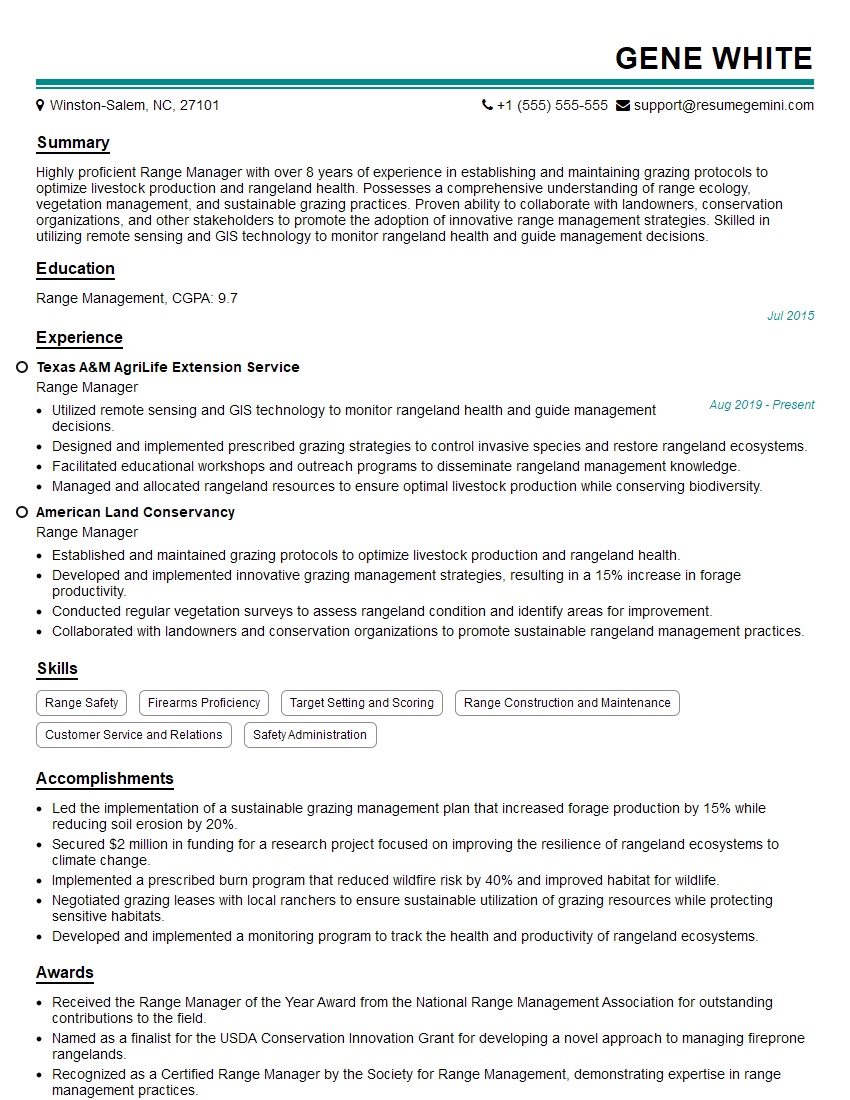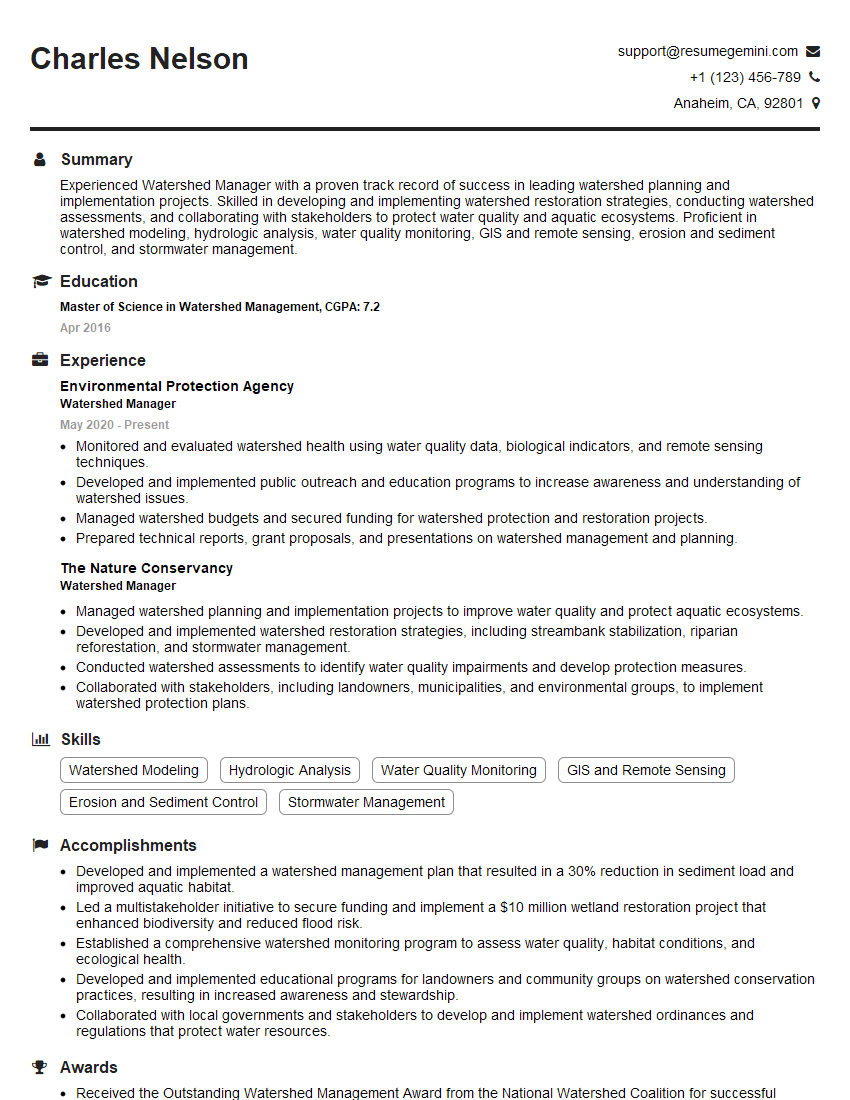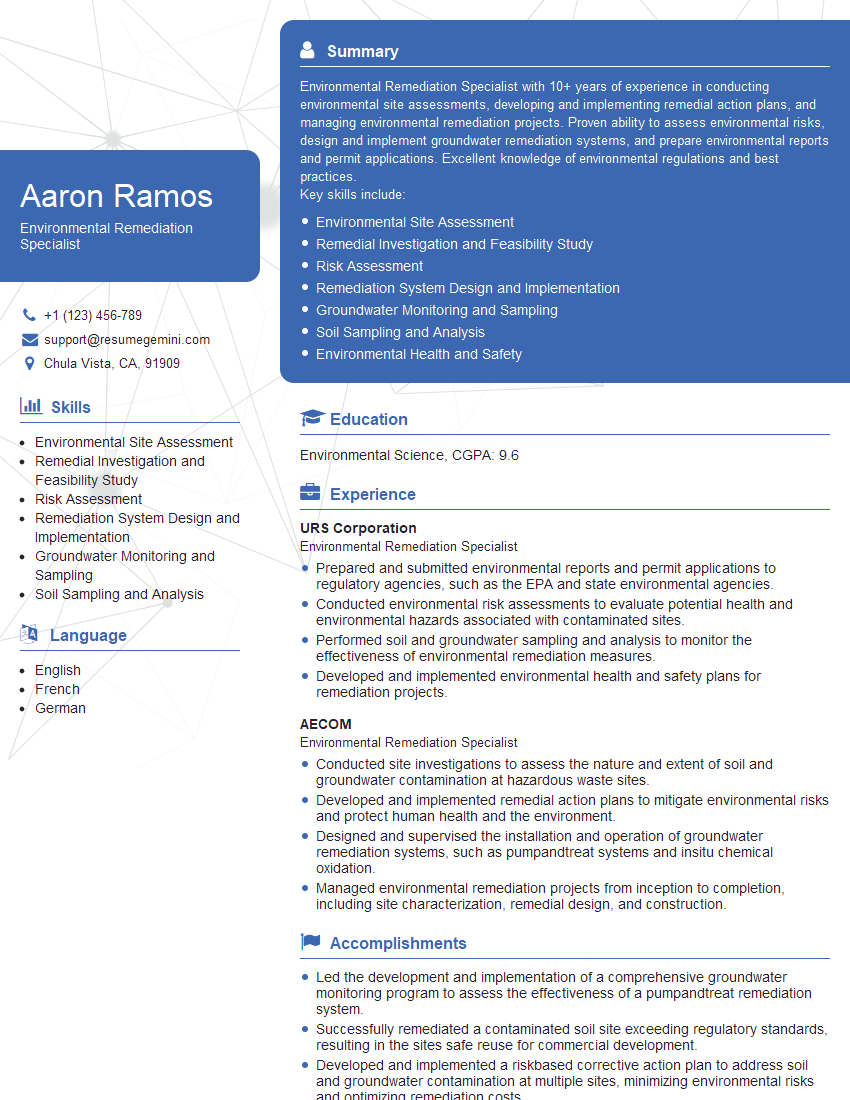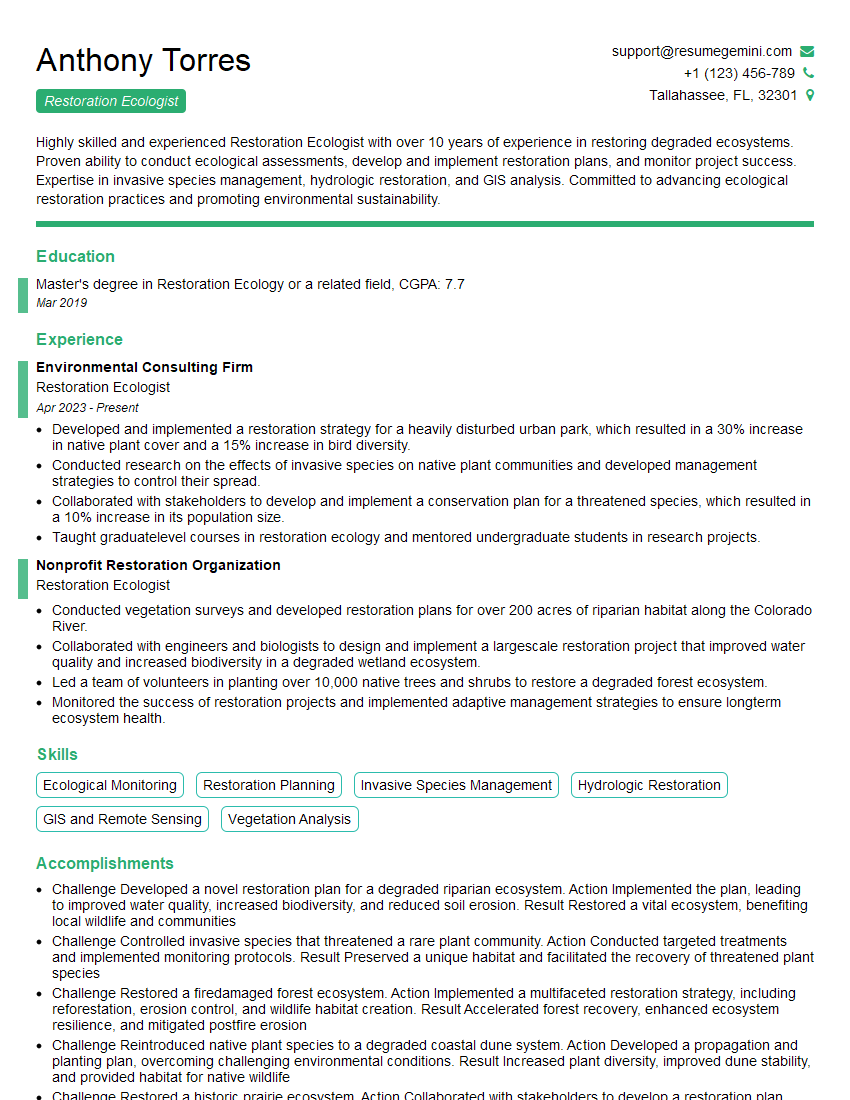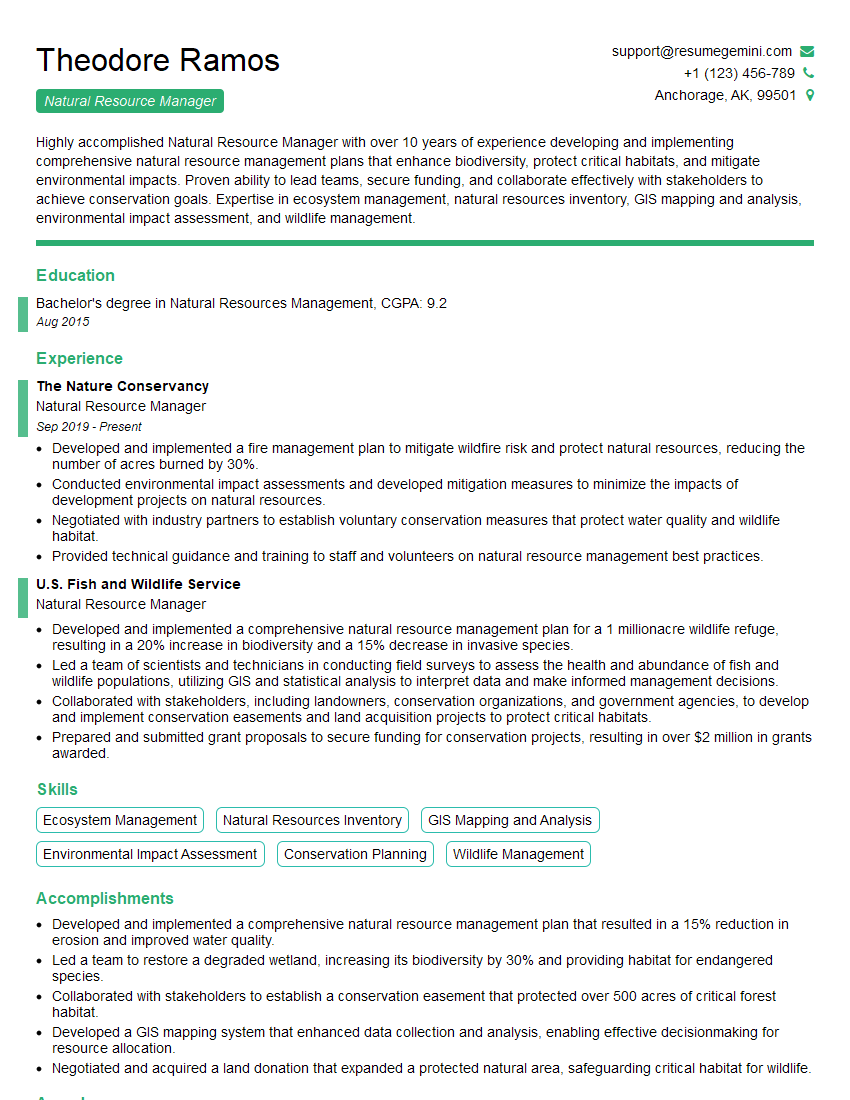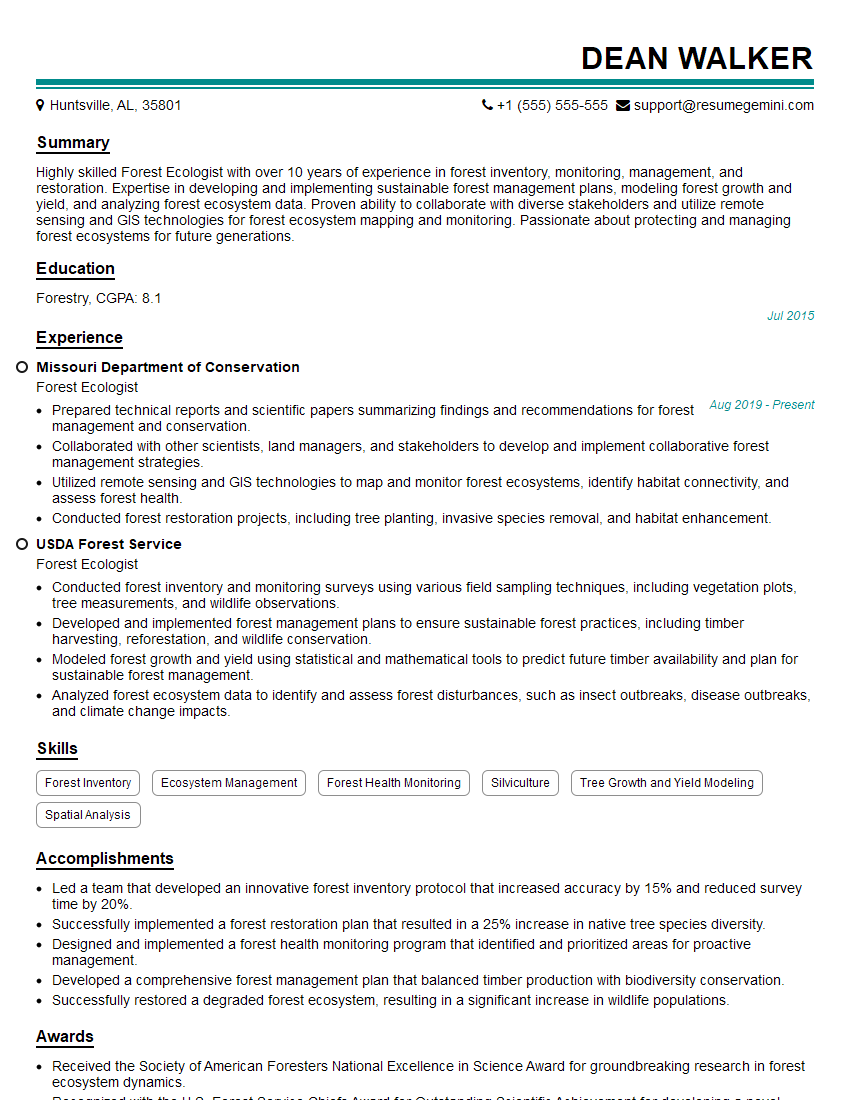Cracking a skill-specific interview, like one for Habitat Modification and Control, requires understanding the nuances of the role. In this blog, we present the questions you’re most likely to encounter, along with insights into how to answer them effectively. Let’s ensure you’re ready to make a strong impression.
Questions Asked in Habitat Modification and Control Interview
Q 1. Describe your experience with invasive species control techniques.
Invasive species control is a multifaceted field requiring a tailored approach for each species and ecosystem. My experience encompasses a range of techniques, from mechanical removal to biological control and chemical treatments. For example, I’ve worked on projects targeting Japanese knotweed (Fallopia japonica) where we employed a combination of repeated cutting and herbicide application to deplete the rhizome reserves. In another project involving the control of zebra mussels (Dreissena polymorpha) in a lake, we implemented a targeted application of a molluscicide alongside the introduction of a natural predator, a type of fish that feeds on the mussels, resulting in a significant reduction of their population.
The selection of a control method heavily depends on factors like the target species’ life cycle, the extent of the infestation, the surrounding ecosystem’s sensitivity, and cost-effectiveness. It’s crucial to consider potential non-target effects and adopt integrated pest management strategies for sustainable and effective outcomes.
Q 2. Explain the process of conducting a habitat assessment.
A habitat assessment is a systematic process to evaluate the ecological characteristics of a specific area. It involves a multi-step approach, starting with defining the study area and its objectives. The next step involves data collection. This may include field surveys to identify plant and animal species, soil analysis to determine soil type and nutrient levels, and water quality testing if the habitat involves aquatic systems. Remote sensing technologies, such as aerial photography and satellite imagery, can significantly assist in gathering large-scale data.
Data analysis involves interpreting collected data to describe the habitat’s current condition, identify any threats or stressors (e.g., pollution, invasive species, habitat fragmentation), and assess the habitat’s capacity to support its existing species. This leads to the final step: creating a comprehensive report outlining the findings and recommendations for habitat management or restoration.
For example, during a wetland assessment, we’d examine vegetation composition, water depth and flow, and the presence of indicator species to determine the wetland’s health and identify any degradation factors.
Q 3. What are the key considerations for designing a habitat restoration project?
Designing a successful habitat restoration project necessitates a holistic approach considering several key aspects. Firstly, setting clear, measurable, achievable, relevant, and time-bound (SMART) goals is crucial. These should align with the desired ecological outcome. For instance, the goal might be to increase the population of a specific endangered species or restore the biodiversity of a degraded forest patch.
Understanding the historical context of the habitat is paramount. What was the habitat like before degradation? What are the limiting factors? This information informs the design of restoration strategies, including species selection, planting densities, and the implementation of appropriate management practices. The project design should also include a robust monitoring plan to track progress, evaluate effectiveness, and allow for adaptive management adjustments as needed. Finally, engaging local stakeholders, such as landowners and communities, through participatory planning ensures project success and lasting impact.
Q 4. How do you determine the success of a habitat modification project?
Determining the success of a habitat modification project is a long-term endeavor, going beyond simply observing immediate changes. We use various metrics to assess success, tailored to the project’s specific goals. For example, if the aim is to increase bird populations, we’d monitor nesting success, bird species richness, and abundance. Similarly, for wetland restoration, we’d measure water quality parameters, vegetation cover, and the presence of indicator species.
Monitoring should occur over several years to account for natural fluctuations and to assess long-term trends. Statistical analysis of the collected data helps to determine whether significant improvements have been achieved compared to pre-project conditions or established benchmarks. We also conduct comparative analyses across different sites or control areas to ensure that observed changes are directly attributable to the restoration efforts.
Q 5. What are the common challenges in habitat restoration?
Habitat restoration faces numerous challenges. Funding limitations are a common obstacle. Restoring degraded habitats can be expensive and time-consuming, requiring substantial resources for land acquisition, site preparation, planting, and long-term monitoring. Another major challenge is dealing with invasive species. These species can quickly re-colonize restored areas, undermining restoration efforts. For example, controlling the spread of aggressive weeds often necessitates repeated treatments and can significantly increase project costs.
Furthermore, climate change poses significant challenges. Changing weather patterns can affect the survival and growth of planted species, making restoration efforts less predictable and effective. Lastly, a lack of public awareness and support can hinder project implementation and long-term success. Education and outreach are crucial to garner community involvement and secure ongoing support for conservation efforts.
Q 6. Explain your experience with GIS mapping for habitat analysis.
GIS mapping is an indispensable tool in habitat analysis and modification. I have extensive experience utilizing GIS software (e.g., ArcGIS, QGIS) to create and analyze spatial data related to habitat characteristics. This includes mapping vegetation types, identifying areas with high species richness or endemism, assessing habitat fragmentation, and modeling species distributions.
For example, I used GIS to overlay data on elevation, slope, aspect, and soil type to identify suitable locations for reforestation efforts. Similarly, I’ve used spatial analysis tools to assess the connectivity of fragmented habitats and design wildlife corridors to facilitate species movement. The ability to visualize and analyze spatial data in GIS significantly enhances the effectiveness and precision of habitat management and restoration projects.
Q 7. Discuss your knowledge of endangered species and their habitat requirements.
My knowledge of endangered species and their habitat requirements is extensive. I understand that each species has unique ecological needs, which need to be carefully considered during habitat management and restoration projects. This includes understanding their specific dietary requirements, breeding habits, and tolerance to environmental variations. For example, the California condor (Gymnogyps californianus) requires large, undisturbed territories with access to cliffs for nesting, and specific food sources. Similarly, the Florida panther (Puma concolor coryi) needs expansive, contiguous tracts of forested wetlands to hunt and reproduce.
Understanding these requirements is crucial for designing effective conservation strategies. This includes habitat protection, restoration, and management actions aimed at improving habitat quality and ensuring species survival. Conservation efforts may involve controlling invasive species, restoring degraded habitats, or establishing protected areas to safeguard critical habitats.
Q 8. Describe your familiarity with various habitat types (e.g., wetland, forest, grassland).
My familiarity with various habitat types is extensive, encompassing detailed knowledge of their ecological characteristics, flora, fauna, and associated environmental processes. For instance, wetland habitats, including marshes, swamps, and bogs, require a deep understanding of hydrology, water chemistry, and the unique adaptations of wetland species. Forest habitats demand expertise in forest ecology, silviculture (the science of forest management), and the intricacies of forest succession. Grassland ecosystems necessitate knowledge of grazing patterns, fire ecology, and the diversity of grassland plant communities. I’ve worked directly with all three, conducting assessments, developing management plans, and overseeing restoration projects.
- Wetlands: I’ve led projects assessing the impacts of agricultural runoff on coastal salt marshes and developed restoration plans to improve water quality and enhance biodiversity.
- Forests: My experience includes working on forest fragmentation studies, assessing the impacts of logging on endangered species, and designing sustainable forestry practices.
- Grasslands: I’ve been involved in projects restoring degraded grasslands through prescribed burning and invasive species control, aiming to improve habitat for native prairie birds.
Q 9. How do you balance conservation goals with human development needs?
Balancing conservation goals with human development needs is a crucial aspect of my work, requiring a multifaceted approach. It involves understanding the trade-offs, employing mitigation strategies, and promoting sustainable development practices. This often translates to finding creative solutions that minimize environmental impact while allowing for necessary infrastructure or economic development. For example, in a recent project involving a new road construction through a forested area, we worked with the developers to design wildlife crossings, minimize habitat fragmentation through strategic route planning, and implement buffer zones to protect sensitive ecosystems.
This balance is achieved through collaborative efforts involving stakeholders such as government agencies, developers, community groups, and environmental organizations. It demands robust environmental impact assessments, thorough public consultation, and the implementation of effective monitoring programs.
Q 10. Explain your experience with permit acquisition for habitat modification projects.
Acquiring permits for habitat modification projects is a complex process requiring familiarity with various regulations and permitting agencies. My experience encompasses navigating the complexities of federal, state, and local regulations, preparing comprehensive permit applications, and successfully obtaining necessary approvals. This involves a detailed understanding of environmental laws, including the Clean Water Act, Endangered Species Act, and National Environmental Policy Act. I’ve successfully managed the permit acquisition process for a wide range of projects, including wetland mitigation banks, stream restoration, and controlled burns.
The process typically includes site assessments, environmental impact statements, species surveys, and consultation with regulatory agencies. I can provide a clear example of a recent project involving a coastal development where obtaining permits required extensive coordination with the Army Corps of Engineers, the state environmental agency, and the National Marine Fisheries Service to ensure compliance with all relevant regulations.
Q 11. What are the ethical considerations in habitat manipulation?
Ethical considerations in habitat manipulation are paramount. They extend beyond mere compliance with regulations to encompass a broader consideration of ecological integrity, biodiversity, and social justice. It’s crucial to prioritize the long-term well-being of ecosystems and the species that inhabit them, minimizing harm and promoting resilience. This includes carefully assessing the potential impacts on endangered or threatened species and implementing mitigation measures to offset any negative consequences.
For instance, when considering a habitat restoration project, an ethical approach involves engaging with local communities, considering their perspectives, and ensuring that the project benefits them as well. Transparency and public participation are vital to ethical habitat management. A key ethical dilemma often arises when balancing the needs of a particular species with the needs of an entire ecosystem. We need to avoid unintended consequences and ecological imbalances.
Q 12. How do you monitor the effectiveness of habitat management strategies?
Monitoring the effectiveness of habitat management strategies is crucial for evaluating their success and making necessary adjustments. This involves establishing clear objectives, selecting appropriate monitoring indicators, implementing data collection protocols, and analyzing results to assess progress. For example, in a wetland restoration project, we might monitor water quality parameters, vegetation cover, and the abundance of key indicator species to assess the effectiveness of our restoration efforts.
Monitoring can involve various methods, including species surveys, vegetation mapping, water quality testing, and remote sensing techniques. Data analysis involves statistical tools to determine if there has been a significant change in the parameters being monitored. Regular reporting to stakeholders is essential to maintain transparency and accountability.
Q 13. What are the different methods for controlling erosion in modified habitats?
Controlling erosion in modified habitats is essential for maintaining ecological stability and preventing sedimentation of waterways. Several methods can be employed, depending on the specific site conditions and the nature of the modification. These methods are often combined for optimal results.
- Vegetation: Planting native vegetation, including grasses, shrubs, and trees, is a primary method. Roots bind soil particles, reducing erosion. The type of vegetation chosen depends on the soil type, climate, and desired ecological outcome.
- Engineering Controls: This includes structures like retaining walls, check dams, and terraces to control water flow and stabilize slopes. These measures are often used in conjunction with vegetation to provide additional protection against erosion.
- Mulching: Applying mulch to the soil surface provides a protective layer, reducing the impact of rainfall and wind erosion. Organic mulches eventually decompose, improving soil health.
- Contour Farming: Plowing and planting along the contours of the land helps slow down water runoff and reduce soil erosion. This technique is particularly useful on slopes.
Q 14. Describe your experience with hydrological modeling in habitat restoration.
Hydrological modeling plays a vital role in habitat restoration projects, particularly in wetland and riparian ecosystems. It allows us to simulate water flow, predict water table levels, and assess the impact of restoration activities on the hydrological regime. This is crucial for designing effective restoration plans and ensuring that the modified habitat can support the intended species and functions. I have significant experience using hydrological models, such as MIKE SHE and HEC-RAS, to simulate the impact of different restoration scenarios on water flow, sediment transport, and nutrient cycling.
For instance, in a river restoration project, hydrological modeling helped us predict the effects of removing an old dam on downstream flow regimes and water quality, allowing us to design compensatory measures to minimize negative impacts on aquatic habitats. The models helped us simulate the impact of various restoration scenarios and choose the optimal solution for restoring the natural hydrological flow.
Q 15. How do you adapt habitat management strategies to climate change?
Adapting habitat management to climate change requires a proactive, multifaceted approach. We can no longer manage habitats in isolation from the changing climate; instead, we must anticipate and mitigate the impacts of altered temperature regimes, precipitation patterns, and extreme weather events.
For example, in managing coastal wetlands facing sea-level rise, strategies might include assisted migration – relocating species to more suitable habitats further inland – or managed retreat, allowing the wetland to naturally migrate. In forests, we might focus on assisted gene flow, introducing trees with greater resilience to drought or heat stress. This involves careful genetic analysis to maintain biodiversity while boosting adaptation. Another critical aspect is enhancing habitat connectivity, allowing species to shift their ranges as needed. This might involve creating wildlife corridors or restoring degraded habitats along migration routes.
Essentially, climate change adaptation in habitat management is about building resilience. This involves not just predicting the impacts but actively guiding ecosystems towards a future where they can persist despite ongoing climate shifts.
Career Expert Tips:
- Ace those interviews! Prepare effectively by reviewing the Top 50 Most Common Interview Questions on ResumeGemini.
- Navigate your job search with confidence! Explore a wide range of Career Tips on ResumeGemini. Learn about common challenges and recommendations to overcome them.
- Craft the perfect resume! Master the Art of Resume Writing with ResumeGemini’s guide. Showcase your unique qualifications and achievements effectively.
- Don’t miss out on holiday savings! Build your dream resume with ResumeGemini’s ATS optimized templates.
Q 16. Explain your familiarity with different types of habitat connectivity.
Habitat connectivity refers to the degree to which different patches of habitat are linked, allowing for the movement of organisms and the flow of genetic material. There are several types, each with its implications for conservation:
- Structural connectivity: The physical presence of a link between habitats, such as a wildlife corridor or a river. For example, a forested corridor linking two fragmented forest patches provides structural connectivity.
- Functional connectivity: The actual movement of organisms between habitats. Even with a structural link, functional connectivity might be low if barriers exist (e.g., roads, fences) or if the habitat quality in the corridor is poor.
- Genetic connectivity: The exchange of genes between populations. This is crucial for maintaining genetic diversity and preventing inbreeding depression.
Understanding the different types of connectivity is crucial for effective habitat management. For instance, simply creating a physical corridor (structural connectivity) isn’t enough; we also need to ensure that the corridor is functionally suitable for the target species (functional connectivity) and enables sufficient gene flow (genetic connectivity).
Q 17. How do you evaluate the cost-effectiveness of various habitat restoration techniques?
Evaluating the cost-effectiveness of habitat restoration involves a multifaceted approach combining ecological and economic assessments. We need to consider both the upfront costs and long-term benefits.
For instance, we could use a cost-benefit analysis (CBA) framework. This involves estimating the costs of different restoration techniques (labor, materials, equipment) and quantifying the ecological benefits (e.g., increased biodiversity, improved water quality, carbon sequestration). We can then use economic valuation methods, such as hedonic pricing (changes in property values) or contingent valuation (willingness to pay surveys), to put a monetary value on these ecological benefits.
A life-cycle assessment (LCA) might also be employed. An LCA examines the environmental impacts of a restoration technique across its entire life cycle, from material extraction to disposal. Comparing LCAs of different techniques helps assess their overall sustainability and potential cost savings in the long run.
Ultimately, cost-effectiveness is not solely about minimizing expenses; it’s about maximizing the ecological return on investment. A restoration technique may have a higher upfront cost but deliver much greater long-term ecological and economic benefits, making it a more cost-effective choice.
Q 18. What are the key factors influencing habitat suitability for a specific species?
Habitat suitability for a specific species depends on a complex interplay of factors, often categorized as:
- Resource availability: Food, water, shelter, nesting sites – all are critical. For example, a bird species requires specific vegetation types for nesting and insects for food.
- Environmental conditions: Temperature, humidity, light, soil type – these can directly influence a species’ survival and reproduction. A wetland species, for instance, needs specific water conditions.
- Disturbance regime: The frequency and intensity of natural disturbances (e.g., fire, floods) can shape habitat structure and species composition. Some species thrive in frequently disturbed areas, others need stable, undisturbed habitats.
- Biotic interactions: Competition, predation, parasitism, mutualism – interactions with other species can strongly influence habitat suitability. A species may be limited by competition for resources or predation pressure.
Understanding these factors requires thorough ecological knowledge of the species in question. We might use species distribution models (SDMs) – statistical models that predict species occurrence based on environmental factors – to identify suitable habitats.
Q 19. Describe your experience with community engagement in habitat restoration projects.
Community engagement is integral to successful habitat restoration. It fosters ownership, increases project longevity, and builds support.
My experience has included organizing workshops and public forums to educate stakeholders on restoration goals and methods. We often involve local communities in data collection, such as vegetation surveys or monitoring wildlife populations, empowering them to actively participate in the process. Citizen science initiatives offer an excellent avenue for this.
Furthermore, partnering with local organizations, landowners, and indigenous communities ensures that projects are culturally sensitive and address local priorities. This collaborative approach minimizes conflict and leverages the knowledge and insights of those who live and work within the landscape.
For example, I worked on a project restoring a riparian zone where we collaborated closely with local farmers who were initially skeptical of the project. By involving them in the planning and implementation stages, highlighting the benefits to their farms (e.g., improved water quality, reduced erosion), we were able to gain their support and secure their long-term commitment.
Q 20. What are the regulatory frameworks governing habitat modification in your region?
(Note: The regulatory framework for habitat modification varies significantly by region and country. The following is a general overview and should not be considered legal advice.)
In many regions, habitat modification is governed by a complex web of laws and regulations aimed at protecting biodiversity and ecological integrity. These often include:
- Environmental impact assessments (EIAs): Projects that might significantly impact habitats are usually required to undergo an EIA to assess potential environmental consequences and propose mitigation measures.
- Endangered Species Acts (or equivalents): These laws protect threatened and endangered species and their habitats, often prohibiting activities that could harm them.
- Water quality regulations: These regulations set limits on pollution and protect aquatic habitats.
- Land-use planning regulations: These regulations guide how land is used and developed, often incorporating habitat protection objectives.
Specific permits and approvals might be needed before undertaking any habitat modification activity. These processes often involve consultation with government agencies and other stakeholders.
Q 21. How do you incorporate data analysis and modeling into your habitat management decisions?
Data analysis and modeling are essential for effective habitat management. They enhance decision-making by providing objective insights and predictions.
We routinely utilize Geographic Information Systems (GIS) to map habitats, analyze spatial patterns, and identify key areas for conservation or restoration. Remote sensing data (satellite imagery, aerial photography) provides valuable information on habitat condition and change over time.
Statistical modeling, such as species distribution models (SDMs) mentioned earlier, helps predict species occurrences and assess habitat suitability under different scenarios. Population viability analysis (PVA) helps estimate the probability of a species’ persistence under varying conditions.
For example, before initiating a restoration project, we might use SDMs to identify the most suitable locations for planting specific vegetation types based on soil conditions, moisture availability, and other environmental factors. Similarly, PVAs can inform decisions about the minimum habitat area needed to maintain a viable population of a particular species.
Essentially, data-driven approaches are transforming habitat management from a largely intuitive practice to a more scientific, predictive, and ultimately more effective discipline.
Q 22. Describe your experience with using remote sensing technologies for habitat monitoring.
Remote sensing technologies are invaluable for habitat monitoring, offering a cost-effective and efficient way to gather large-scale data. I have extensive experience utilizing techniques like satellite imagery (Landsat, Sentinel), aerial photography, and LiDAR. For example, in a recent project focused on mangrove restoration in the Sundarbans, we used multispectral satellite imagery to assess mangrove canopy cover, identify areas of deforestation, and monitor the growth of newly planted mangroves over time. The data was processed using GIS software to create detailed maps showing changes in habitat extent and health. Another example involved using LiDAR data to create high-resolution digital elevation models (DEMs) to map wetland topography and identify suitable locations for wetland restoration projects. This approach allows for precise identification of areas at risk and facilitates targeted intervention strategies. Analyzing spectral signatures in the imagery allows us to identify specific vegetation types and assess their health, providing crucial insights into habitat quality.
Q 23. How do you prioritize habitat restoration projects based on ecological importance?
Prioritizing habitat restoration projects hinges on a multi-faceted approach, combining ecological principles with socioeconomic factors and stakeholder engagement. We use a structured framework prioritizing areas based on several key criteria: Endangered Species Presence: Projects protecting critically endangered species or those with the highest conservation priority are prioritized first. Biodiversity Hotspot Identification: Areas with high species richness and endemism are given high priority. Ecosystem Services Value: We consider the value of ecosystem services provided by the habitat, such as carbon sequestration, water purification, or flood control. Feasibility and Cost-Effectiveness: This assesses the logistical feasibility, considering land ownership, accessibility, and potential restoration costs. We often use a weighted scoring system assigning points to each criterion based on their importance and using this as a guide for project selection. For example, a project restoring a crucial breeding ground for an endangered bird species in a highly threatened ecosystem would be ranked very highly compared to a project with lower biodiversity value and higher restoration costs.
Q 24. What are the potential impacts of habitat fragmentation on biodiversity?
Habitat fragmentation, the breaking up of large, continuous habitats into smaller, isolated patches, has significant negative impacts on biodiversity. These impacts include: Reduced Population Size: Smaller populations are more vulnerable to inbreeding depression, genetic drift, and stochastic events (like disease outbreaks). Loss of Habitat Specialists: Many species are adapted to specific habitat types and cannot survive in the fragmented landscape. Increased Edge Effects: Increased edge-to-interior ratio exposes species to greater predation, parasitism, competition from invasive species, and altered microclimates. Reduced Gene Flow: Isolation limits gene exchange between populations, reducing genetic diversity and the adaptive capacity of populations to environmental change. Increased Habitat Isolation: Fragmentation disrupts ecological processes such as pollination and seed dispersal, making it more difficult for species to persist. For example, the construction of roads through forests can fragment the habitat, leading to the decline of forest-dependent species due to habitat loss and increased edge effects. This highlights the importance of considering connectivity in habitat management and restoration efforts.
Q 25. Explain your understanding of the ecological principles behind habitat restoration.
Ecological principles underpinning habitat restoration are rooted in understanding the natural processes that shaped the habitat and the interactions between its components. Key principles include: Ecosystem Resilience: Restoration aims to create a self-sustaining system capable of withstanding disturbance and change. Functional Connectivity: Restoring ecological processes like nutrient cycling, water flow, and seed dispersal requires consideration of the landscape context and the connections between different habitats. Succession and Disturbance Regimes: Understanding natural successional pathways and the role of disturbance in maintaining biodiversity guides restoration planning. Species Interactions: Restoration considers the interactions between different species and their roles within the ecosystem. For instance, restoring a degraded wetland involves understanding the role of hydrology in shaping vegetation communities and carefully managing water levels to create appropriate habitat conditions for target species. Successful restoration often involves mimicking natural processes to create a self-sustaining ecosystem.
Q 26. How do you address conflicts between different stakeholder interests in habitat management?
Addressing stakeholder conflicts in habitat management requires open communication, collaborative problem-solving, and a commitment to finding mutually acceptable solutions. I use a multi-step approach: Stakeholder Identification and Engagement: Identifying all relevant stakeholders (e.g., landowners, local communities, government agencies, conservation groups) and engaging them early in the process. Conflict Analysis: Understanding the root causes of conflicts, the needs and interests of each stakeholder, and the potential trade-offs involved. Negotiation and Mediation: Facilitating discussions between stakeholders, fostering mutual understanding, and exploring potential compromises. Adaptive Management: Regularly monitoring the effects of management decisions and adapting the approach as needed based on stakeholder feedback and ecological monitoring data. For example, in a project involving restoring a riparian zone along a river, we had to navigate competing interests between agricultural land use and the conservation needs of riparian species. Through collaborative discussions and compromise, we developed a management plan that balanced agricultural needs with habitat protection measures.
Q 27. Describe your experience working with diverse teams on habitat restoration projects.
I thrive in diverse team environments, recognizing the value of varied perspectives and expertise. My experience working with teams on habitat restoration spans across various disciplines, including ecologists, engineers, social scientists, GIS specialists, and community members. For example, in a large-scale wetland restoration project, the team comprised hydrologists who designed the water management system, botanists who selected native plant species, and community members who were involved in the planting and monitoring. Effective communication and clear roles are essential for successful teamwork. I emphasize building trust, ensuring everyone feels heard, and fostering a collaborative spirit where each team member’s contribution is valued. Regular team meetings, transparent communication, and the establishment of shared goals are crucial for successful project implementation.
Q 28. How do you stay up-to-date on the latest advancements in habitat modification and control techniques?
Staying current in habitat modification and control techniques requires a proactive and multi-pronged approach. I regularly attend conferences, workshops, and professional development courses focused on restoration ecology, conservation biology, and related fields. I actively engage with professional organizations such as the Society for Ecological Restoration and the Wildlife Society. I subscribe to scientific journals and regularly search relevant databases for publications on emerging techniques. I also actively participate in online communities and forums focusing on habitat restoration to exchange information with other professionals. This continuous learning helps me stay abreast of the latest scientific advances, technological innovations, and best practices in the field, ensuring I’m utilizing the most effective approaches in my work.
Key Topics to Learn for Habitat Modification and Control Interview
- Habitat Assessment and Monitoring: Understanding techniques for evaluating existing habitats, identifying key species and their interactions, and employing various monitoring methods to track changes over time. Practical application includes designing and implementing monitoring programs for specific projects.
- Restoration Ecology Principles: Grasping the theoretical foundations of habitat restoration, including ecological succession, species reintroduction, and the role of disturbance in shaping ecosystems. Practical application involves developing restoration plans for degraded habitats, considering factors like site selection, species choice, and long-term management strategies.
- Control Techniques for Invasive Species: Familiarizing yourself with different methods for managing and controlling invasive species, including mechanical, chemical, and biological controls. Practical application includes assessing the effectiveness of various control methods based on specific ecological contexts and environmental regulations.
- Sustainable Land Management Practices: Understanding the principles of sustainable land management in relation to habitat modification and control. This includes practices that minimize environmental impact while achieving conservation goals. Practical application involves integrating these practices into habitat management plans.
- Environmental Regulations and Permitting: Knowing relevant environmental laws and regulations pertaining to habitat modification and control projects. This ensures compliance and ethical project execution. Practical application includes navigating the permitting process for habitat alteration projects.
- GIS and Remote Sensing Applications: Understanding how Geographic Information Systems (GIS) and remote sensing technologies are used to analyze habitat data, plan interventions, and monitor project outcomes. Practical application includes utilizing GIS software to map habitats, analyze spatial patterns, and model potential impacts.
- Project Planning and Management: Demonstrating proficiency in developing comprehensive project plans, managing budgets, coordinating teams, and ensuring timely completion of habitat modification and control projects.
Next Steps
Mastering Habitat Modification and Control opens doors to exciting and impactful careers in conservation, environmental management, and ecological restoration. To maximize your job prospects, creating a strong, ATS-friendly resume is crucial. ResumeGemini is a trusted resource that can help you build a professional and effective resume tailored to highlight your skills and experience in this field. Examples of resumes tailored to Habitat Modification and Control are available to further guide your preparation.
Explore more articles
Users Rating of Our Blogs
Share Your Experience
We value your feedback! Please rate our content and share your thoughts (optional).
What Readers Say About Our Blog
Hello,
We found issues with your domain’s email setup that may be sending your messages to spam or blocking them completely. InboxShield Mini shows you how to fix it in minutes — no tech skills required.
Scan your domain now for details: https://inboxshield-mini.com/
— Adam @ InboxShield Mini
Reply STOP to unsubscribe
Hi, are you owner of interviewgemini.com? What if I told you I could help you find extra time in your schedule, reconnect with leads you didn’t even realize you missed, and bring in more “I want to work with you” conversations, without increasing your ad spend or hiring a full-time employee?
All with a flexible, budget-friendly service that could easily pay for itself. Sounds good?
Would it be nice to jump on a quick 10-minute call so I can show you exactly how we make this work?
Best,
Hapei
Marketing Director
Hey, I know you’re the owner of interviewgemini.com. I’ll be quick.
Fundraising for your business is tough and time-consuming. We make it easier by guaranteeing two private investor meetings each month, for six months. No demos, no pitch events – just direct introductions to active investors matched to your startup.
If youR17;re raising, this could help you build real momentum. Want me to send more info?
Hi, I represent an SEO company that specialises in getting you AI citations and higher rankings on Google. I’d like to offer you a 100% free SEO audit for your website. Would you be interested?
Hi, I represent an SEO company that specialises in getting you AI citations and higher rankings on Google. I’d like to offer you a 100% free SEO audit for your website. Would you be interested?
good
